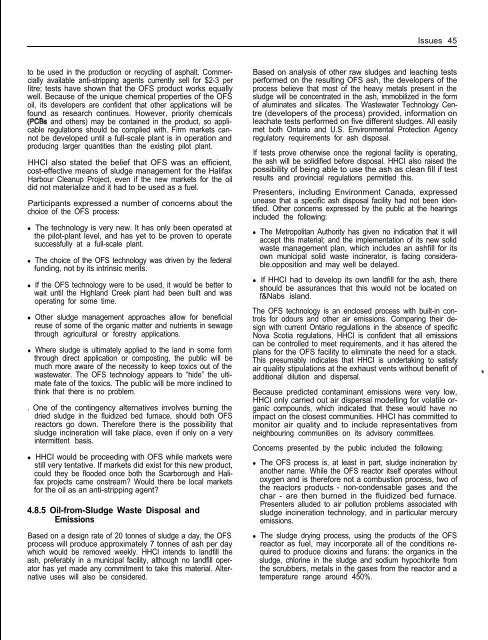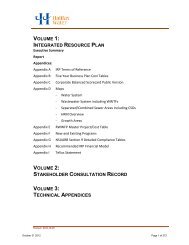Halifax Harbour Cleanup Inc. - Halifax Regional Municipality
Halifax Harbour Cleanup Inc. - Halifax Regional Municipality
Halifax Harbour Cleanup Inc. - Halifax Regional Municipality
You also want an ePaper? Increase the reach of your titles
YUMPU automatically turns print PDFs into web optimized ePapers that Google loves.
Issues 45<br />
to be used in the production or recycling of asphalt. Commercially<br />
available anti-stripping agents currently sell for $2-3 per<br />
litre; tests have shown that the OFS product works equally<br />
well. Because of the unique chemical properties of the OFS<br />
oil, its developers are confident that other applications will be<br />
found as research continues. However, priority chemicals<br />
(PCBs and others) may be contained in the product, so applicable<br />
regulations should be complied with. Firm markets cannot<br />
be developed until a full-scale plant is in operation and<br />
producing larger quantities than the existing pilot plant.<br />
HHCI also stated the belief that OFS was an efficient,<br />
cost-effective means of sludge management for the <strong>Halifax</strong><br />
<strong>Harbour</strong> <strong>Cleanup</strong> Project, even if the new markets for the oil<br />
did not materialize and it had to be used as a fuel.<br />
Participants expressed a number of concerns about the<br />
choice of the OFS process:<br />
• The technology is very new. It has only been operated at<br />
the pilot-plant level, and has yet to be proven to operate<br />
successfully at a full-scale plant.<br />
• The choice of the OFS technology was driven by the federal<br />
funding, not by its intrinsic merits.<br />
• If the OFS technology were to be used, it would be better to<br />
wait until the Highland Creek plant had been built and was<br />
operating for some time.<br />
• Other sludge management approaches allow for beneficial<br />
reuse of some of the organic matter and nutrients in sewage<br />
through agricultural or forestry applications.<br />
• Where sludge is ultimately applied to the land in some form<br />
through direct application or cornposting, the public will be<br />
much more aware of the necessity to keep toxics out of the<br />
wastewater. The OFS technology appears to “hide” the ultimate<br />
fate of the toxics. The public will be more inclined to<br />
think that there is no problem.<br />
. One of the contingency alternatives involves burning the<br />
dried sludge in the fluidized bed furnace, should both OFS<br />
reactors go down. Therefore there is the possibility that<br />
sludge incineration will take place, even if only on a very<br />
intermittent basis.<br />
• HHCI would be proceeding with OFS while markets were<br />
still very tentative. If markets did exist for this new product,<br />
could they be flooded once both the Scarborough and <strong>Halifax</strong><br />
projects came onstream? Would there be local markets<br />
for the oil as an anti-stripping agent?<br />
4.8.5 Oil-from-Sludge Waste Disposal and<br />
Emissions<br />
Based on a design rate of 20 tonnes of sludge a day, the OFS<br />
process will produce approximately 7 tonnes of ash per day<br />
which would be removed weekly. HHCI intends to landfill the<br />
ash, preferably in a municipal facility, although no landfill operator<br />
has yet made any commitment to take this material. Alternative<br />
uses will also be considered.<br />
Based on analysis of other raw sludges and leaching tests<br />
performed on the resulting OFS ash, the developers of the<br />
process believe that most of the heavy metals present in the<br />
sludge will be concentrated in the ash, immobilized in the form<br />
of aluminates and silicates. The Wastewater Technology Centre<br />
(developers of the process) provided, information on<br />
leachate tests performed on five different sludges. All easily<br />
met both Ontario and U.S. Environmental Protection Agency<br />
regulatory requirements for ash disposal.<br />
If tests prove otherwise once the regional facility is operating,<br />
the ash will be solidified before disposal. HHCI also raised the<br />
possibility of being able to use the ash as clean fill if test<br />
results and provincial regulations permitted this.<br />
Presenters, including Environment Canada, expressed<br />
unease that a specific ash disposal facility had not been identified.<br />
Other concerns expressed by the public at the hearings<br />
included the following:<br />
• The Metropolitan Authority has given no indication that it will<br />
accept this material; and the implementation of its new solid<br />
waste management plan, which includes an ashfill for its<br />
own municipal solid waste incinerator, is facing considerable.opposition<br />
and may well be delayed.<br />
• If HHCI had to develop its own landfill for the ash, there<br />
should be assurances that this would not be located on<br />
f&Nabs island.<br />
The OFS technology is an enclosed process with built-in controls<br />
for odours and other air emissions. Comparing their design<br />
with current Ontario regulations in the absence of specific<br />
Nova Scotia regulations, HHCI is confident that all emissions<br />
can be controlled to meet requirements, and it has altered the<br />
plans for the OFS facility to eliminate the need for a stack.<br />
This presumably indicates that HHCI is undertaking to satisfy<br />
air quality stipulations at the exhaust vents without benefit of<br />
additional dilution and dispersal.<br />
Because predicted contaminant emissions were very low,<br />
HHCI only carried out air dispersal modelling for volatile organic<br />
compounds, which indicated that these would have no<br />
impact on the closest communities. HHCI has committed to<br />
monitor air quality and to include representatives from<br />
neighbouring communities on its advisory committees.<br />
Concerns presented by the public included the following:<br />
• The OFS process is, at least in part, sludge incineration by<br />
another name. While the OFS reactor itself operates without<br />
oxygen and is therefore not a combustion process, two of<br />
the reactors products - non-condensable gases and the<br />
char - are then burned in the fluidized bed furnace.<br />
Presenters alluded to air pollution problems associated with<br />
sludge incineration technology, and in particular mercury<br />
emissions.<br />
• The sludge drying process, using the products of the OFS<br />
reactor as fuel, may incorporate all of the conditions required<br />
to produce dioxins and furans: the organics in the<br />
sludge, chlorine in the sludge and sodium hypochlorite from<br />
the scrubbers, metals in the gases from the reactor and a<br />
temperature range around 450%.

















